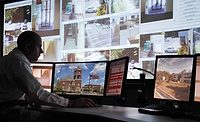3 Steps to Campus Security


Loyola University has taken steps to address all layers of campus security, including Freestanding Emergency Phone Towers from Talkaphone that cover the first security layer for Loyola University and are the most common of the upgrades found on campus. The towers stand nine-feet tall and are two-way communication phones for individuals in need of assistance. Image courtesy of Talkaphone


It’s been discussed that the overall way to address current and future security obstacles on college campuses is by improving campus coverage. Campus coverage is the area that an acting police or security department can safeguard/patrol at one time. During the recent economic downturn many campus police and security departments have had to downsize, resulting in a decrease in coverage. Even before that, many departments were still unable to simultaneously watch over large areas of their campuses due to expansive infrastructure and improper or deteriorating communication tools.
In order to maximize the coverage of college police and personnel, many departments looked to address three key layers of security.
The first layer, emergency communication, addresses the connection from student and faculty to police. Many colleges discovered that it was hard for their student population to quickly get in contact with campus dispatchers or patrolmen. Frequently, campuses lacked convenient and noticeable emergency phones. At locations with phones, many were antiquated, neglected, or left in disrepair. To make matters worse, students, when using their personal phones, did not know the direct phone number to campus police or security. This lack of connectivity led to slow response times and confusion for both officers and the individuals who needed help.
Layer two is mass notification capability. A standard for schools across the country is to have some way for police and personnel to communicate with the mass campus population. Many colleges incorporate email and text messages as their mass notification solutions, but that might not be enough. Emails and text messages aren’t always received and read at necessary times. Students, such as those walking to and from classes, might not look at their email.
The third layer, surveillance, covers the ability of campus police and security to watch and patrol areas where an officer might not currently be. Universally, you will find surveillance cameras at all colleges. Unfortunately, many cameras are not utilized until after a crime or emergency has occurred. Many campuses lack ways to utilize their cameras in real-time scenarios, whether that be following a suspicious individual or patrolling a 360-degree area.
Loyola University, located in Chicago, Illinois, has been at the forefront of implementing increased campus coverage. Loyola’s police department has focused on improving emergency communication, mass notification and surveillance and is now one of the safest campuses in the country. Loyola has a student base of nearly 16,000 students spread out across multiple campuses, and along with the key layers of campus security, it has worked with Talkaphone.
Bill Curtin, Loyola’s Director of Environmental Services, and previous Director of Public Safety, was tasked with improving safety and security on campus. “We wanted to address all areas of campus security,” says Curtin. “We originally had emergency phones that were outdated and starting to fail. Additionally, those phones did not meet ADA requirements. We felt that newer emergency phones could address multiple layers of security. Due to these factors we wanted to upgrade. I had previously dealt with Talkaphone at another location and I knew it would cover what we needed.”
Over the next several years Curtin had Talkaphone emergency towers, wall mount and mass notification speakers installed across each Loyola University campus.
Freestanding emergency phone towers cover the first security layer for Loyola University and are the most common of the upgrades found on campus. The towers stand nine-feet tall and are two-way communication phones for individuals in need of assistance. They act as campus perimeter indicators, sporting a LED blue light that can be seen across campus. Extension arms equipped with cameras are added on top of the towers to provide individual identification during an activation, as well as general surveillance. Curtin says: “We wanted something that was durable, had high visibility and provided a quick connection to the caller. We wanted the units to be recognizable and easily visible no matter where you are on campus. The towers are no more than 300 feet apart from each other, which makes sure that students are only 150 feet away from a phone at any time.”
To address Loyola’s mass notification needs (the second layer of security), Curtin had WEBS® towers and paging units installed throughout each campus. The WEBS towers include bright LED blue lights, camera arms and a direct line of communication through a phone. They also include four mass notification speakers that provide 360-degree coverage.
“We also utilize WEBS Contact software to manage and operate our mass notification messages,” says Curtin. “It allows us to easily utilize and organize the messages we broadcast from our WEBS towers and indoor speakers.” WEBS Contact, in conjunction with WEBS Towers, allows Loyola’s police dispatchers to maintain several prerecorded mass notification messages that can be broadcasted throughout multiple or single towers.
Getting Smart with Emergency Planning AppsThese days a tablet or smartphone is as essential for college students as a backpack, a meal plan, and extra long twin sheets. But it’s not the hardware that’s so important – it’s the apps. One app from SchoolDude is disseminating emergency information available via mobile devices campus-wide at Northwest Missouri State University (Northwest) for the school’s students, faculty and staff. With more than 6,000 students and a 240-acre campus, the app is not only notifying students about emergencies on campus, but also offers actions to take with visual icons, know-how guides and specific instructions. “The app gives us the flexibility needed to customize and publish the policies and procedures in the format we prefer and clearly shares easy-to-read instructional diagrams,” says Lieutenant Mike Ceperley, Emergency Management Coordinator with the Northwest University Police. “A huge part of the mobile app’s benefit to our community is that it is accessible even when communications and power are lost.” Prior to using the CrisisManager solution from SchoolDude, emergency response procedures were available to students, faculty and staff on the Northwest Missouri State University Police website. Available as an iOS and Android app, emergency plans also include phone contacts and online resources where users can access more information both with the university and Maryville, Missouri, officials. Ceperley adds that his favorite aspect of the system is “The flexibility needed to customize and publish the crisis response policies and procedures instantly to a wide audience, based on their specific roles and responsibilities on campus. One of the biggest benefits to the Northwest community is that the app is accessible even when communications and power are lost. There is a tremendous amount of helpful emergency information right at our community’s fingertips, and helping our students and employees know what to do when a crisis situation occurs is a top priority at Northwest. Parents have been really excited to learn about the app too.” “We have used the app for severe weather events including tornados and winter weather,” he says. “CrisisManager provides specific response plans, which we have customized, detailing how to find alternative heating sources during a power failure, driving tips in the event of a storm, what to do if you are stranded, among other scenarios.” |
An additional benefit of the WEBS towers is the ability to broadcast messages directly from a unit location. In the back of each tower is a handheld microphone allowing individual officers to make on-the-fly messages through the tower loudspeaker. This gives officers flexibility if a mass notification broadcast needs to be made immediately. Additionally, complementing the towers and software at Loyola University are the indoor paging units. These units are placed in discreet indoor locations and can provide clear and intelligent messages, just like their outdoor complement.
All of the towers on the Loyola University campuses provide a quick and uninterrupted connection to campus dispatchers. This means that when a tower is activated an individual does not have to press and hold a button every time he/she wishes to talk. This allows that individual to address their current situation without having to handicap one hand. Additionally, when a tower is activated, the campus dispatcher knows the exact location of the caller. This saves the dispatch center time in trying to figure out the location of the call.
Addressing the third layer of security, Curtin had surveillance cameras installed on top of each tower. The cameras are operational before, during, and after an activation, allowing the dispatch center to watch, evaluate and identify a situation before officers arrive on scene. “The towers near our athletics fields are frequently activated. Those calls address sports injuries or some type of medical emergency,” Curtin says. “We’ve had some instances where an individual has activated a phone to report a robbery or assault off campus.”
Looking for a reprint of this article?
From high-res PDFs to custom plaques, order your copy today!









